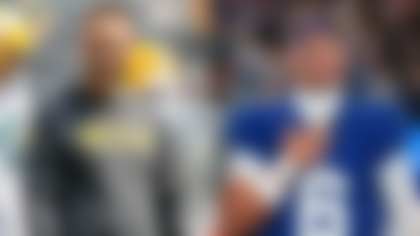Former NFL player and scout Bucky Brooks knows the ins and outs of this league, providing keen insight in his notebook. The topics of this edition include:
-- The best secondary in the NFL this season doesn't reside in Seattle or Denver.
-- A very interesting quirk in Tom Brady's approach this season.
-- How will Adrian Peterson fare in Arizona?
But first, a look at the surprising struggles from one of the NFL's young stars ...
* * * **
What's wrong with Amari Cooper?
The Raiders' WR1, who earned Pro Bowl berths after his first two seasons (both 1,000-yard campaigns), has hardly made an impact as a playmaker this season, to the point where I don't recognize No. 89. Although there are only five games in the books in 2017, Cooper's pedestrian stat line -- 13 receptions, 118 receiving yards and one touchdown -- suggests that something isn't right with his game.
Whether it's the chemistry between the third-year pro and his MVP-caliber quarterback, adjusting to a new role in a retooled offense led by a new play caller (first-year offensive coordinator Todd Downing) or opponents paying close attention to his tendencies as a route runner and playmaker, there is something going on with Cooper that is keeping him from playing like a superstar on the perimeter.
From a production standpoint, Cooper certainly isn't impacting the game like a No. 1 receiver. He's averaging just 6.6 targets, 2.6 receptions and 23.6 receiving yards per game in 2017, after averaging 8.2 targets, 4.8 receptions and 69.5 receiving yards during his first two seasons (2015 and '16). Not to mention, Cooper ranks worst in the NFL among receivers with at least 30 targets in drops (five), drop percentage (27.8), receiving percentage or catch rate (39.4), receiving yards per target (3.6) and passer rating when targeted (34.7).
If that's not enough to set off alarm bells, the fact that he hasn't posted a 100-yard game since Week 8 of the 2016 regular season (when he had 12 receptions for 173 yards against Tampa Bay) should raise some serious concerns about his disappearing act on the perimeter.
Elite receivers are expected to produce big numbers as the focal point of the passing game, and those expectations don't change when opponents begin to send double-coverage or brackets to their side. The best pass catchers in the business not only find a way to get open against loaded coverage, but they punish opponents who leave them alone in one-on-one matchups.
"A wide receiver is really a No. 1 guy if he commands a double-team," a former NFL defensive coordinator told me. "If we need to give him special attention to prevent him from dominating the game, then you know you're dealing with a real dude on the perimeter. If we feel like we can cover him without tricks or gadgetry, then he's not a real No. 1 in my mind."
While that coach's opinion is certainly subjective, he does bring up a good point when discussing Cooper and his disappointing production this season. Is it a byproduct of Cooper facing more double-teams on the outside, or have opponents figured out his game?
Having studied the All-22 Coaches Film, I believe opponents have read the book on Cooper and adjusted their coverage tactics accordingly. As one of the top prospects in the 2015 draft class, the 6-foot-1, 210-pound receiver out of Alabama was an outstanding playmaker with polished routes and strong hands. He torched defenders with his diverse route-running skills, exhibiting exceptional timing and precision getting in and out of breaks. In addition, Cooper kept defenders off-balance with an assortment of stems and releases that compromised their leverage.
As a pro, Cooper continued to torment defenders with his clever route-running skills. If defensive backs attempted to shadow him from distance (7 or 8 yards off at the line of scrimmage), he consistently ate them up on a variety of short and intermediate routes. Cooper's stop-start quickness and burst made it nearly impossible to stay with him on quick-rhythm routes like slants, hitches, digs and outs.
Fast-forward to 2017, and defensive backs have figured out that eliminating free access at the line makes it tougher for Cooper to impact the game on the outside. Thus, you're seeing more defenders walk up and press him at the line (bump-and-run coverage), to make him earn his catches and yards.
"He doesn't respond well to press coverage and physicality," an AFC secondary coach told me. "When defenders put their hands on him and knock him around a little bit, they can take him out of the game."
Studying Cooper's performance against the Denver Broncos (two catches for 9 yards in Week 4) and Baltimore Ravens (one catch for 8 yards in Week 5), I noticed that each team primarily used press techniques in its man and zone coverages to prevent him from rolling right into his route. The defenders used one- or two-hand jams at the line of scrimmage to disrupt the timing and rhythm of his route. With defenders staying attached at the hip down the field, Cooper has been unable to consistently get open against press coverage.
According to Next Gen Stats, Cooper produces the fifth-worst passer rating against press coverage (64.2) and the eighth-worst catch rate (46.2 percent) in the league (among pass catchers with 10 or more press targets). That's certainly not the production that you expect from a WR1, particularly a two-time Pro Bowler who was expected to dominate as Derek Carr's favorite playmaker on the outside.
Looking at the Raiders' scheme and tactical approach, I believe Oakland could do more to help Cooper escape press coverage. Downing can move his WR1 around via motion, shifts or exotic formations to give him more room at the line of scrimmage. In addition, the Raiders can position him in the slot, to allow him to use "two-way" releases against softer nickelbacks in coverage.
The Raiders also need to consider mixing up Cooper's route tree to prevent defenders from squatting on his routes. Just looking at the tape, I noticed that he runs a lot of slants, hitches and hinges (deep hitch) from an out-wide alignment. Cooper also tips off his routes with his alignment at the snap. Defenders can quickly anticipate which routes he is running based on his proximity to the numbers (hash-split rules), and they are adjusting their leverage accordingly. Not to mention, defenders are also clued in to Oakland's passing-game tactics from certain formations, particularly 3x1 formations and empty sets.
With defenders fully aware of what's coming from No. 89, the Raiders' No. 1 receiver has been essentially eliminated from the passing game this season. In fact, I will suggest that Cooper has been erased from the Raiders' aerial attack since the middle of last season, when the Broncos and Texans provided a blueprint for defending the crafty pass catcher.
Considering his struggles date back to Week 9 of 2016, the onus is on the 2-3 Raiders' coaching staff to come up with some creative ways to free Cooper from coverage. With the season hanging in the balance, we will see if Oakland can expand the playbook to get No. 89 back on track.
JAGUARS' SECONDARY: The best defensive backfield in the NFL today
It might take the rest of the football world a few more weeks to reach this conclusion, but the Jacksonville Jaguars have the best defensive backfield in the league.
No disrespect to the Seahawks' "Legion of Boom" or the Broncos' "No Fly Zone," but Jalen Ramsey, A.J. Bouye, Aaron Colvin, Barry Church and Tashaun Gipson are the new lockdown kings of the NFL.
Now, I know that statement is going to stir up a hornet's nest in my mentions, but you might want to pause before you @ me on Twitter.
The Jaguars rank third in pass defense (177.8 yards per game), while holding opponents to a 58.8 percent completion rate (fifth). Not to mention, opposing quarterbacks own a 3:10 touchdown-to-interception ratio and a 56.9 passer rating (lowest in the league).
If those numbers aren't impressive enough, the fact that Bouye (38.3) and Ramsey (47.1) rank first and second in passer rating allowed (min. 25 targets) should open some eyes, particularly with each guy holding opposing quarterbacks to sub-50 percent completion rate (Bouye at 42.9, Ramsey at 47.1) while also each notching a pair of interceptions. That's the kind of production that you would expect from a shutdown corner, right? So that must mean the Jaguars have two lockdown specialists on their roster, with Bouye and Ramsey vying for the No. 1 role.
"You'd rather have two guys that want the challenge (of being the shutdown guy) than not have the challenge," Jaguars secondary coach Perry Fewell told reporters during training camp, via the St. Augustine Record. "I think it bodes well for both of them. When you look at different styles of receivers, you know the No. 1 guy and the No. 2 guy in this league, they are very similar. Sometimes Jalen may match up good with the big guy and A.J. may match up good with a smaller, quick guy."
Studying the All-22 Coaches Film, it's easy to see that the Jaguars' lockdown specialists are rare finds at the position as skilled technicians with polished footwork and superb instincts. Each can employ a variety of tactics and techniques on the island to snuff out pass catchers.
Ramsey is the longer, more athletic playmaker of the two. The second-year man, who was taken fifth overall in the 2016 NFL Draft, combines world-class athleticism (at Florida State, Ramsey won the 2015 ACC indoor and outdoor long-jump titles) with an alpha dog demeanor and a rugged game. Ramsey embraces the physical aspect of playing the position, as evidenced by his aggressive bump-and-run style, yet he also displays the patience and discipline to shadow receivers from distance. In addition, Ramsey shows outstanding instincts, awareness and ball skills on the perimeter. He has registered 23 passes defensed in 21 career games, as well as four interceptions and a forced fumble. That impact production stands out on tape, as you watch him quickly close in on receivers off breaks. Ramsey's burst, acceleration and explosiveness make him nearly impossible to shake when he's locked in and focused.
Bouye is a high-IQ player without extraordinary footspeed and short-area quickness. The fifth-year player -- who stunningly went undrafted in 2013 and signed with Jacksonville this past offseason after four years with the Texans -- is a coach's dream on the perimeter with a game that looks like it was plucked straight from a clinic tape. From his polished footwork and fundamentals to his flawless turns and transitions to his superb instincts and diagnostic skills, Bouye plays the position in textbook fashion. He is rarely out of place when the ball is thrown; this consistent positioning allows him to routinely make plays on the ball. In 2017, Bouye has seven passes defensed, but that doesn't include the number of errant passes he has forced due to sticky coverage.
With Bouye and Ramsey locking down the outer edges of the field, quarterbacks are forced to throw the ball between the hashes against a trio of defenders who make life miserable for pass catchers over the middle. Church, Gipson and Colvin aren't household names, but their complementary games form the perfect triangle in the middle of the field.
Gipson serves as the centerfielder in the back end. He is expected to roam from numbers to numbers as the deep-ball eraser in a single-high-safety defense. Although disappointing production in 2016 led to concerns about his playmaking ability as a designated ballhawk, he has certainly put those issues to rest with three interceptions in the first five games of this season. Gipson is a "vision" player with a knack for diagnosing routes and anticipating throws. Last season aside, he is quietly one of the best ballhawks in the business; 18 career interceptions validate that point. In a defense where interceptions are the byproduct of tips or overthrows, Gipson's combination of instincts and ball skills make him a game changer at the position.
Church is the enforcer every elite defense needs between the hashes. He thumps like a mad man but also show enough athleticism and range to play as a deep-middle defender at times. His versatility allows the Jaguars to showcase a few looks with No. 42 featured as a blitzer off the edge or as a hole defender sitting at linebacker depth. With Gipson also adept at playing near the line of scrimmage, Jacksonville's defense can use the safeties to toy with quarterbacks during the pre-snap phase.
"It's not like this guy is always down or this guy is always back," coach Doug Marrone told reporters at a presser this week, via Jacksonville.com. "I think those things help. It gives you a chance to mix up the coverages, what is going on, and things of that nature."
Colvin is rarely mentioned when observers talk about the Jaguars' secondary, but the fourth-year pro plays a key role as the team's nickelback. He not only aligns in the slot to neutralize the slippery pass catchers who occupy the WR3 role, but he must be a factor against the ground attack when teams elect to run to the open side in "11" personnel formations (1 RB, 1 TE and 3 WRs). Colvin throws his body around as a feisty tackler, and his willingness to hit allows the Jags to comfortably stay in their nickel defense against most looks. In coverage, Colvin's experience and versatility (can play inside or outside at CB) serves him well in Jacksonville's "see ball, get ball" coverage. He has a great feel for sorting out routes, which allows him to break quickly on the ball to hold pass catchers to minimal gains.
This brings me back to why Jacksonville's secondary has surged to the top of the charts. The pieces of the puzzle fit together nicely in a scheme that showcases each player's respective talents. While some will downgrade the Jaguars for using a set of coverages that are eerily similar to the Seahawks' hybrid Cover 1/Cover 3 system, it's hard to dispute the unit's production and effectiveness neutralizing aerial attacks around the league. Considering the Jags' high number of takeaways (15, tops in the NFL) and the sticky coverage displayed on tape, I dare you to name a defensive backfield that's playing better ...
NEXT GEN STATS: Tom Brady owns the blind side
There's little doubt that Tom Brady is the "G.O.A.T." (Greatest of All Time) at the quarterback position, but I'm amazed NFL defensive coordinators haven't caught up with his approach this season. Granted, he is one of the best clutch performers that I've ever seen, as evidenced by his spectacular performance in Super Bowl LI, among the countless comeback wins in his career, but he is torching opponents working away from the typical strong suit of right-handed quarterbacks. Instead of wearing out defensive backs with a barrage of throws to the right side of the field, Brady is repeatedly directing passes to his blind side.
"He has always preferred to throw to the offensive left (defensive right)," a former AFC defensive coordinator who routinely faced Brady told me. "He's comfortable throwing to that side and he's really good at it. Plus, Brady's sweet spot is between the numbers and the hash, so he doesn't mind wearing you out with a bunch of dink-and-dunk throws to his left."
According to Next Gen Stats, Brady leads all passers with 62 completions to the left this season, racking up 782 yards and five touchdowns for a passer rating of 115.5 (all league-highs, as well).
What's remarkable about Brady's success is his willingness to work the short area of the field to his left. The four-time Super Bowl MVP has completed 33 passes between 0 to 10 yards from the line of scrimmage, which is more than double the league average (16). In addition, Brady has completed 14 passes at an intermediate distance (10 to 20 yards), nearly three times the league average (5).
Comparing Brady's passing heat map with the alignments and route trees of the Patriots' top receivers, some obvious trends emerge. For instance, Brandin Cooks spends a lot of time on the left running an assortment of vertical routes. He aligned out wide on the left on 51 percent of his offensive snaps. In addition, Cooks has received 75 percent of his targets, 67 percent of his receptions and 73 percent of his receiving yards on the left-hand side of the field. Most importantly, he has averaged 23.0 yards per catch on receptions on the left.
Against the Houston Texans in Week 3, Cooks finished with five receptions for 131 yards and two touchdowns, with the bulk of his work done on the left side of the field. In that same game, Rob Gronkowski snagged eight balls for 89 yards and a touchdown with most of his routes ending on the left side of the field. With the Patriots using Cooks to clear the zone on verticals, Gronkowski's crossing routes and option outs were frequently left uncovered.
With that information in mind, I don't know why defensive coordinators don't use field or location calls to discourage Brady from targeting that side.
"We used to discuss all of that information with our players, but Brady is so good at making adjustments that he would tweak his game to exploits our coverage," the former AFC defensive coordinator said. "He would work the other side of the field and target No. 3 or No. 2 on throws inside the numbers. (Defensive coaches number receivers from outside to inside. Thus, No. 1 would be the receiver nearest sideline, with No. 2 representing the slot receiver, etc.) Thus, you're at his mercy when he decides to counter your tactics."
While Brady is pretty efficient working other areas of the field, it is apparent that he wants to work the back side in 2017. It will be interesting to see if opponents adjust their tactics to disrupt the timing and rhythm of the Patriots' passing game.
ADRIAN PETERSON'S NEW HOME: Can the RB save the Cardinals?
I don't know if Bruce Arians rubbed a magic lamp, but the wily old coach is hoping that newly acquired running backAdrian Peterson is the genie who can save the Arizona Cardinals' ailing ground game. While I don't blame the coach for scouring the Earth looking for a remedy after losing star running back David Johnsonto a dislocated wrist in Week 1, I just don't know if the 32-year-old running back is the answer to the team's woes.
Look, I have the utmost respect for what Peterson has accomplished in this league. He ranks fourth in NFL history in rushing yards per game (93.1), behind only Jim Brown (104.3), Barry Sanders (99.8) and Terrell Davis (97.5). He is also one of only seven runners with a 2,000-yard season on the resume, to go along with three NFL rushing titles and 50 100-yard rushing games (49 regular season, 1 postseason) in his 11-year career.
On the surface, Peterson looks like a major upgrade for the Cardinals, based on the memory of Peterson's most recent rushing title (2015), when he tallied 1,485 rushing yards while displaying his trademark violent running style as a workhorse runner. He finished the season with 10 20-plus-yard runs and four 40-plus-yard jaunts as the premier RB1 in the league.
With those numbers still dancing around coaches' heads like sugar plums, I certainly can understand why a team would take a chance on Peterson, despite the veteran runner seemingly struggling with injuries (he missed most of 2016 with a torn meniscus), declining production (Peterson has only averaged 2.39 per carry over the past two seasons) and a one-dimensional game (he's a downhill runner). While that didn't help him land a major role in New Orleans, it made him an attractive option for a team in need of a spark on the ground.
"I've been really pleased with the tape that I saw on him this year," Arians told reporters on Wednesday. "It's just, his opportunities dwindled down there (in New Orleans). And I haven't been satisfied with our running game.
"When [Peterson] was available, we thought it was the best thing for our football team."
Here's the problem:
The Cardinals haven't shown a strong commitment to the run this season. They rank last in rushing-play percentage, 28th in rushing attempts, last in rushing yards per game and last in yards per carry. And their offensive line appears to lack the collective pop to move defenders off the ball.
A talented runner can certainly mask those flaws, as Johnson has demonstrated during his time as the team's RB1. Since 2016, the Cardinals averaged 4.51 yards per rushing attempt and 5.6 yards per play with the Pro Bowler in the backfield. By comparison, they only averaged 2.95 yards per rushing attempt and 4.8 yards per play without Johnson.
Although Peterson is no longer the superhero he was in Minnesota, he still retains the rugged mentality needed to carry a running game as a workhorse. He bristled at the notion of losing a step and didn't appear overly concerned about the Cardinals' offensive-line woes.
"Do I still got it?" Peterson responded to a question this week. "Well, I don't think it's that mentality, 'Do I still got it,' but that's all you hear from the media ... 'Oh, he lost it,' this, that and the other. So, of course, in my mind, [I] was like, OK, I know that's not the case. When I go out there, I'm always putting my best foot forward, and I feel like it will speak for itself."
Based on the All-22 Coaches Film, it is hard to tell how much Peterson has left in the tank. He only gained 81 rushing yards on 27 attempts over four games in New Orleans this season and finished his time with the Saints with just one run over 10 yards (11 yards against Carolina). I like the effort, physicality and toughness that he displayed in limited action, but I would need to see him shoulder a heavy workload to get a better feel for whether he still has the juice as a runner.
Arians, on the other hand, saw enough from Peterson to know that he could fill the void created by Johnson's injury.
"A violent runner who still has it," Arians said of what he saw from Peterson. "He's not 22 anymore, but he still pours it up in there, and it's very exciting."
The Cardinals are desperately seeking a spark in the running game. We'll see if Arians can get a little magic out of Peterson to help the team reverse its fortunes.
Follow Bucky Brooks on Twitter @BuckyBrooks.












